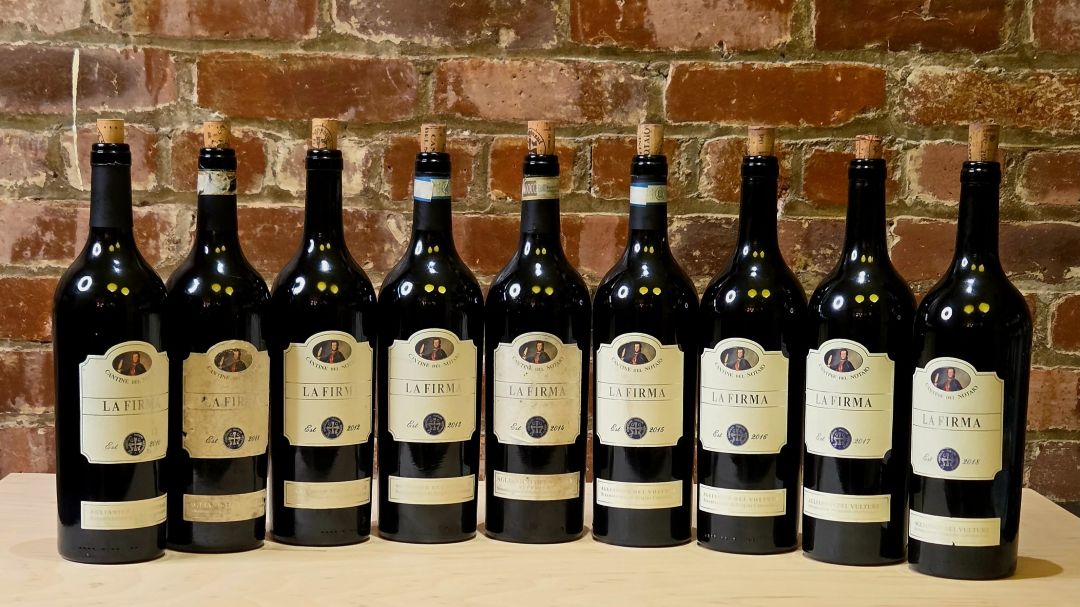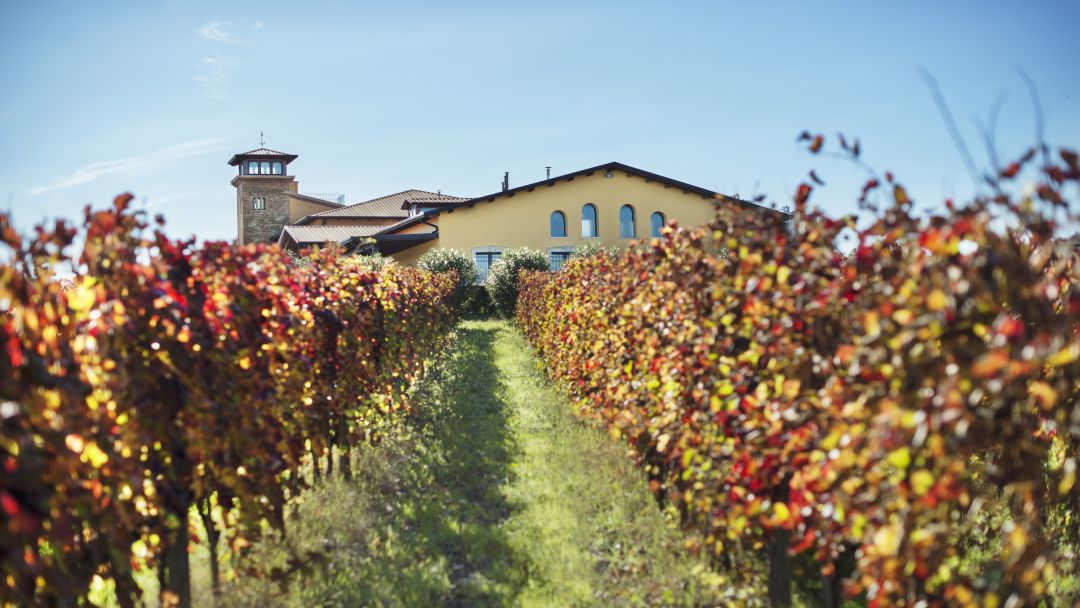Browse using the new Vinous website now. Launch →
Printed by, and for the sole use of . All rights reserved © 2015 Vinous Media
A Vulture Revelation: Mini-Vertical of Cantine del Notaio's La Firma
BY ERIC GUIDO | OCTOBER 20, 2025
Aglianico remains one of Italy's most underrated varieties. While its capacity to age is undisputed, Aglianico’s fantastic ability to communicate terroir with great transparency is less well known, because wines are often masked by a heavy hand in the winery. Moreover, the differences between Aglianico from Campania and Aglianico from Vulture are stark. I love them both, but they are remarkably different. Vulture yields a softer interpretation of the variety, laced with nuances of ash and wild herbs. These wines are slightly more approachable than their siblings in Campania but can still develop beautifully over time. Over a decade ago, Cantine del Notaio was one of the wineries that first introduced me to the possibilities of Vulture Aglianico. The wine was La Firma.

Proprietor Gerardo Giuratrabocchetti began the Cantine del Notaio project at his family's vineyards in Rionero, Vulture, in 1998. Armed with his own degree in agricultural science, Giuratrabocchetti enlisted the renowned oenologist Luigi Moio, owner and winemaker at Quintodecimo, to consult on clonal selection, vineyard management and winemaking. Cantine del Notaio now farms 40 hectares across five communes within the Aglianico del Vulture DOC. Since 2012, Notaio has maintained biodynamic practices, without official certification. The wines lean modern in style, but they are expertly balanced, showcasing Aglianco’s grippy tannins, earthy undertones and formidable dark fruit. The Aglianico del Vulture La Firma is arguably Notaio’s most important wine. This bottling showcases superior fruit purity by way of a gentle hand in the winery, but it is often just barely approachable upon release, which is typically five to six years post-vintage. Long-term aging is the name of the game.
The Cantine del Notaio winery in the town of Rionero.
This vertical tasting of La Firma is a testament to the wine's prestige and possibilities over time. First made in the winery’s first vintage, 1998, the core proportion of fruit for La Firma comes from the village of Maschito, a territory that is highly regarded in Vulture for its mix of high elevations (400-600 meters) and eroded volcanic soils that mix calcareous clays and marls. Vineyards are picked late, typically between the middle and end of November, to ensure proper ripeness and allow for some drying of the berries on the vine. The wine matures in new French oak for one year, followed by extensive bottle aging before release. This combination of ample ripeness, gentle oak impact and bottle age lends La Firma its polish. But make no mistake, this is still an earthy, burly, structured Vulture Aglianico. In the best vintages—such as 2011 and 2014—Cantine del Notaio separated out a small, hand-picked parcel to craft an Aglianico del Vulture Superiore La Firma, which underwent an extra six months of oak aging. As of the 2019 vintage, which will be released in December 2025, Giuratrabocchetti plans to release every subsequent La Firma under the Superiore DOCG.
A few generalizations about the nine wines in this vertical. Firstly, the 2011 lags behind the rest of the wines. It isn’t rare for Aglianico to show intense herbal qualities when first opened, but even after several hours of aeration, the 2011 remained stagnant. The 2010, 2012, 2014, and 2016 La Firmas are fantastic, showcasing exceptional balance and freshness, with all but the 2010 revealing long-aging potential. Interestingly, 2010, 2014 and 2016 were all cool and rainy vintages, which are not typically considered favorable for Aglianico. It seems that Notaio’s practice of late harvesting and strict hand-selection helped offset the difficult conditions. It will be interesting to follow the 2017, another wine from a cool, wet year.

Barrel aging in the caves of Cantine del Notaio, originally built in the 17th century by Franciscan monks.
Conversely, 2012 was a warm vintage, but there's no disputing the wine’s gorgeous balance. The 2015, from another warm year, is very good, but less complex. While many winemakers prefer warmer years when dealing with Aglianico in order to achieve riper tannins, this can sometimes rob the wines of the structure necessary for ageability. The 2018, from a good to very good vintage of ample warmth and sunshine, remains a wildcard and may get even better over time.
I tasted this vertical in New York City in September 2025.
© 2025, Vinous. No portion of this article may be copied, shared or redistributed without prior consent from Vinous. Doing so is not only a violation of our copyright but also threatens the survival of independent wine criticism.
You Might Also Enjoy
Southern Italy: Basilicata, Puglia, Calabria & Molise, Eric Guido, March 2025
Getting in on the Ground Floor: Aglianico del Vulture, Eric Guido, May 2024
Breaking the Mold: Campania’s Push to Reinvent Itself, Eric Guido, May 2024
Southern Italy: Diamonds in the Rough, Eric Guido, July 2023
Basilicata: Vulture’s Rise from the Ashes, Eric Guido, September 2022

